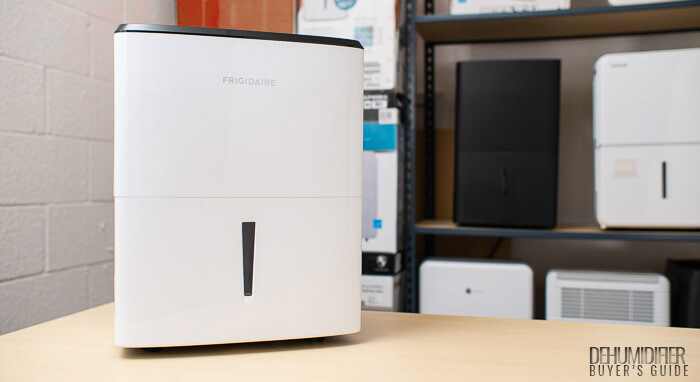
- Compared to other low capacity units, a strong performer in all of our hands-on performance testing
- Compared to all other units, one of the quietest dehumidifiers we’ve tested
- Is equipped with a large water tank for a low capacity dehumidifier
- Compared to high capacity units, not a strong performer in certain hands-on testing
- Only comes with a 1 year warranty
- Dehumidifier
- Instruction Manual
| Energy Efficiency | 5.0 |
| Noise Output | 5.0 |
| Moisture Removal | 5.0 |
| Hygrometer Accuracy | 4.5 |
| Durability | 5.0 |
| Adjustability | 4.5 |
| Versatility | 4.5 |
| Extra Features | 4.0 |
| Ease of Use | 5.0 |
| Portability | 4.0 |
| Warranty | 3.5 |
| Value | 5.0 |
| Editor's Score | 4.5 |
Quick Review Summary
The Frigidaire FFAD2233W1 is the 22 pint equivalent of the top rated 50 pint FFAD5033W1. As such, it shares many of the features and functionality that made the 50 pint unit our top recommended unit overall.
The biggest differences between the two units involve energy efficiency, moisture removal rate, and noise output. The 22 pint FFAD2233W1 is smaller with a smaller sealed system (compressor, condenser, etc.). As such, it doesn’t remove moisture as fast. This also impacts its energy efficiency and noise output.
It’s a negative impact when it comes to energy efficiency – the FFAD2233W1 is less energy efficient than the FFAD5033W1. It’s a positive impact when it comes to noise output – the 22 pint Frigidaire is quieter than its 50 pint equivalent.
We discuss its exact results from all of our performance testing, how it compares to the 50 pint FFAD5033W1, and how it compares to several other competitors in great detail in the review below.
Note that category numerical scores are given according to how this unit compares to other low capacity units – not according to how it compares to higher capacity options.
Performance Test Results
Moisture Removal
We conducted two different moisture removal tests (with 3 trials each and taking the average of those trials).
In the first test we measured how long it took the dehumidifier to lower room humidity from 90% down to 40% relative humidity (RH). In the second test – from 80% down to 50% RH.
The FFAD2233W1 took 24 minutes, 54 seconds in the first test (90% to 40%) and 13 minutes, 6 seconds in the second (80% to 50%).
Most of the other low capacity units we’ve tested were considerably slower in the same tests with most times above 30 minutes in the first test and above 15 minutes in the second.
Higher capacity 50 pint units (unsurprisingly) were much faster. The slowest 50 pint units took about 12 to 14 minutes in the first test. The fastest took only 8 minutes. While the average was about 10 to 11 minutes.
Almost all 50 pint units took between 5 and 6 minutes in the second test.
Energy Efficiency
The 22 pint FFAD2233W1 drew 272 watts of power during testing – a little less than half as much as most of the 50 pint units we tested (high capacity units drew approx. 570 watts in the same test).
As we showed above, the FFAD2233W1 took anywhere between approx. 3x to 2x as long to dehumidify our 50 sq. ft. test space compared to high capacity units (in the most difficult test – 90% to 40% RH).
If it has half the power draw but takes 2x (twice) as long to dehumidify, we can estimate that the FFAD2233W1 has the same approx. energy efficiency as a particular 50 pint unit.
If it has half the power draw but takes more than 3x (three times) longer to dehumidify, it is clearly the less energy efficient option.
The question then is compared to which particular 50 pint units did it take 2x longer and compared to which models did it take 3x longer?
It took 2x longer than only the worst performing 50 pint units. And so, we can say that the FFAD2233W1 is about equally energy efficient as models like the LG UD501KOG5 and Toshiba TDDP5012ES2.
It took 2.5x to 3x longer than the best performing 50 pint units. And so, we can say that the 22 pint FFAD2233W1 is considerably less energy efficient than models like the hOmeLabs HME020031N and especially the Frigidaire FFAD5033W1.
Compared to other low capacity units we’ve tested, the Frigidaire FFAD2233W1 removes moisture much faster and has a lower power draw (the average power draw in the category is over 300 watts). Thus, this unit is more energy efficient than most other low capacity units on the market.
Noise Output
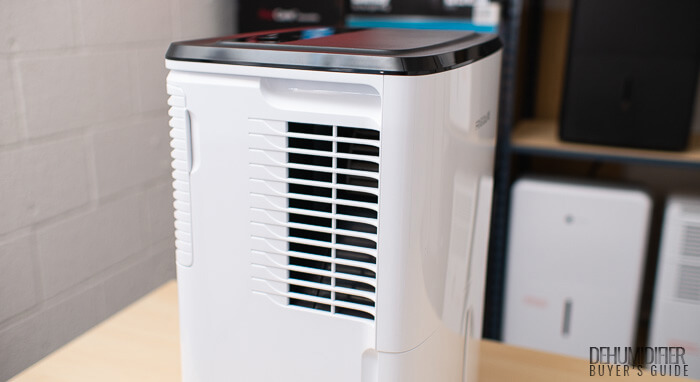
All high capacity (50 pint) dehumidifiers we’ve tested in the last few years produce some type of compressor noise. This is a grating noise that’s very unpleasant to listen to.
Thankfully, the same high capacity units produce quite a bit of fan noise as well. This fan noise is a clean “wind” noise that completely masks compressor noise on the best units.
The problem with this solution (fan noise masking compressor noise) is that it requires the unit to produce a lot of fan noise relative to compressor noise. And the best way to do that is to run the dehumidifier on high fan speed at all times. On this setting the raw noise output is high but the noise output profile is pleasant.
The FFAD2233W1 exhibits much less compressor noise than any 50 pint dehumidifier we’ve tested. As such, you can run it on low fan speed and still mask compressor noise very well. In addition, the 22 pint Frigidaire’s low fan speed is much quieter than low fan speed on a 50 pint unit. This combination of factors allows you to run this unit much more quietly than you can run even the “quietest” 50 pint dehumidifiers.
For example, the FFAD2233W1 was measured at only 44.6 dB on low fan speed 10 ft. away from the dehumidifier. The “quietest” 50 pint dehumidifier we tested, the hOmeLabs HME020031N, was measured at 50.3 dB on high fan speed and 48.8 dB on low fan speed at the same distance.
The bottom line – the FFAD2233W1 is an excellent choice if low noise output is a priority for you.
Hygrometer Accuracy
The 22 pint FFAD2233W1 exhibited exactly the same hygrometer accuracy as its 50 pint equivalent – the FFAD5033W1. It read humidity to within 2% of the actual room humidity.
The most accurate built-in hygrometers exhibited an accuracy of ±1%. The most inaccurate hygrometers read humidity levels 5 to 11% over the actual room humidity.
Included Features, Functionality, Build Quality, Warranties, and Value
Durability (Build Quality)
General Impressions
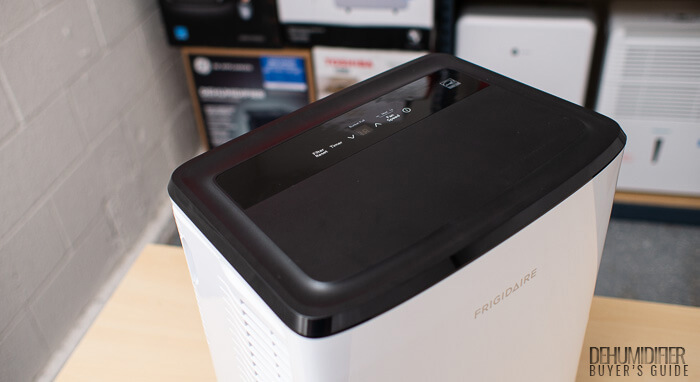
The FFAD2233W1 exhibits much the same build quality as the FFAD5033W1 – that is to say it’s very well built using higher quality materials than what we find used for most of its competition.
Consumer Feedback
This unit is new to the market at this time and so we cannot use consumer feedback (yet) to better help us understand potential long term reliability concerns.
Overall Category Score
Our own observations indicate that this is a highly durable dehumidifier. It earns a perfect 5/5 in the category.
Adjustability
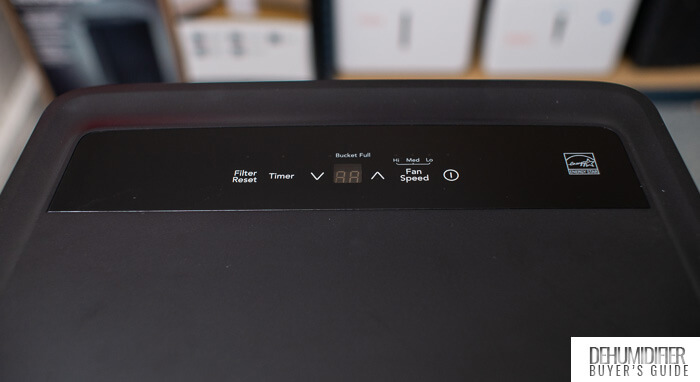
The FFAD2233W1 features an identical control panel to that of the FFAD5033W1 and so it features identical adjustability:
Its humidistat is adjusted in 5% increments. It features a timer that’s adjusted in half hour increments up to 10 hours and 1 hour increments past 10 hours up to 24 hours. It features a continuous mode, 3 fan speeds, and no auto mode.
Most other compressor based dehumidifiers we’ve tested feature similar adjustability although most come with only 2 fan speeds.
On a 50 pint unit 2, even 3 fan speeds isn’t very useful because you’ll almost always want to run the unit on high fan speed to mask compressor noise.
On this 22 pint Frigidaire, the medium and low fan speeds are actually useful as you don’t need to run the unit on high to mask compressor noise – it also does it sufficiently on medium and low. Of course, lowering fan speed reduces noise output and so you can set the unit to run more quietly by setting it to medium or low.
Overall Category Score
The FFAD2233W1 earns a well above average 4.5/5 in the category.
Versatility
Set Humidity Range
Again, most of the specifications here mirror those of the 50 pint unit. Like its 50 pint equivalent, the 22 pint Frigidaire can be set to 35% to 85% RH. When set to 45% RH, for example, the unit will stay on for as long as it takes to lower room humidity down to 45% RH and then cycle off when the threshold is met. It will then automatically cycle back on when room humidity goes back up above 45% RH.
Operating Temperature Range
41° F to 89° F (sometimes 90° F) is the industry standard and the same applies to this 22 pint Frigidaire.
Gravity Drainage
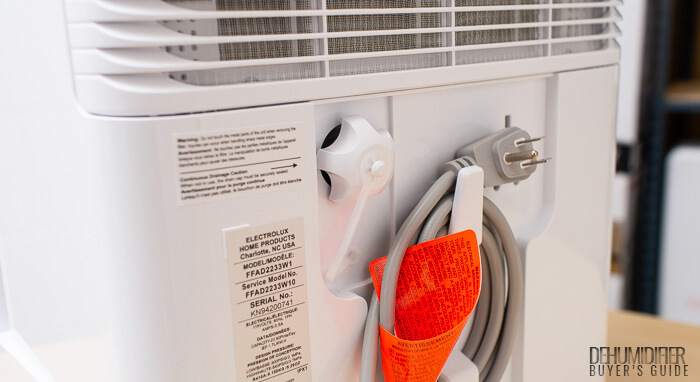
The unit features a drain outlet on the back. It’s threaded for a standard garden hose.
The same functionality exists for virtually every other compressor based dehumidifier on the market.
Built-in Pump
This unit does not feature a built-in pump.
Overall Category Score
The Frigidaire earns a 4.5/5 in the category.
Extra Features
Temperature Reading
This unit does not display a temperature reading. This feature wasn’t present on any of the dehumidifiers we’ve tested in the last few years.
Defrost
Much like the FFAD5033W1, this unit features passive defrosting. It doesn’t have a separate dedicated defrost “mode” but has instead been optimized to prevent frost build-up, as long as it’s used in temperatures no colder than 41° F.
Check Filter
The unit does feature a check filter light.
Overall Category Score
The FFAD2233W1 earns a 4/5 in the category.
Ease of Use
LED Display Clarity
This unit features a high quality, easy to read LED display.
Setup Difficulty
The control panel is properly labeled so that there’s a good chance you’ll be able to use this unit without ever needing to reference its manual.
Filter Removal Difficulty
The filter is easily accessed by removing the back grille.
Manual Clarity
The manual is well written and illustrated.
Water Tank Size
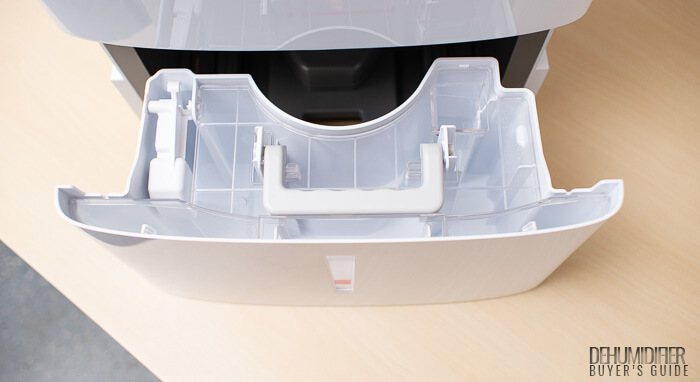
This unit’s tank capacity is only 9.1 pints. For comparison, most 50 pint units have a tank capacity of about 14 pints. The FFAD5033W1 has an above average sized tank capacity of 16.9 pints.
Of course, the FFAD2233W1, as a whole, is much smaller than the 50 pint FFAD5033W1.
And compared to its direct competition – other low capacity units on the market – it actually has a slightly larger tank. The Honeywell TP30WKN, for example, comes with only 7 pint tank. The Black + Decker BDT20WTB comes with only an 8 pint tank. The GE ADEL20LY comes with only a 6.8 pint tank, etc.
Overall Category Score
Despite its small tank the FFAD2233W1 scores a perfect 5/5 in the category. Why? Because it only has a “small” tank compared to much larger dehumidifiers. Compared to other 20 and 22 pint units its tank is actually larger than average.
Portability
As we alluded to in the previous section, this unit is much smaller than its 50 pint equivalent. It’s also much lighter. The FFAD2233W1 is only 20” tall and weighs about 35 lb. The FFAD5033W1 is over 24” tall and weighs 43 lb.
The FFAD2233W1 features side pocket handles and excellent cord storage on the back (you can wrap the power cord around two plastic hooks on the back).
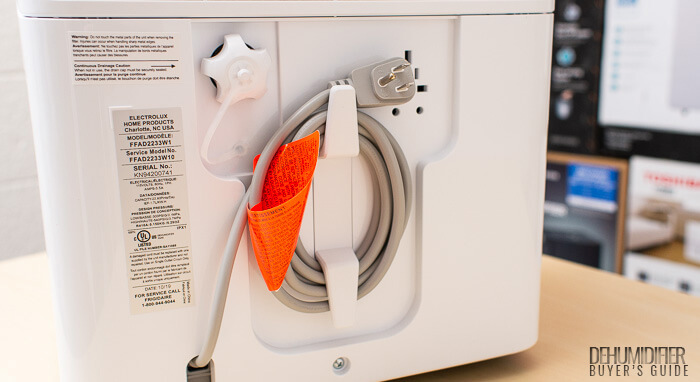
Overall Category Score
If portability is a priority for you the FFAD2233W1 is an excellent choice. However, there are smaller and lighter low capacity options on the market and for this reason this unit only earns a 4/5 in the category.
Warranty (Manufacturer’s)
The FFAD2233W1 comes with the same 1 year warranty as the FFAD5033W1. Most compressor based dehumidifiers on the market today come with a similar 1 year warranty.
If you’re looking for a unit with a longer manufacturer’s warranty we recommend you take a look at hOmeLabs dehumidifiers. hOmeLabs units come with a 2 year warranty and you can add an additional 6 months to the included warranty by registering your purchase with the manufacturer.
Value
The FFAD2233W1 is a great value for a 22 pint dehumidifier, if only because we believe it’s the best 22 pint dehumidifier on the market and it’s not usually priced much higher than other 22 pint options.
Final Thoughts
Generally, we strongly prefer and recommend full-size 50 pint options. However, the FFAD2233W1 can still be a good option
1. if you have a very small room to dehumidify
2. if quiet operation is a strong priority for you
3. if high portability is a strong priority for you
Have a question or comment? Let us know below.
I have an 800 square foot space. Would this 22 pint be sufficient for my needs
For 800 square feet I would recommend a full size 50 pint unit like this one.
How does the back panel of the Frigidaire ffad2234wi 22 pint unit detach?
Our FFDA2233W10 keeps turning off on its own before reaching the programmed setting.
I have an open floor plan between the two levels of our contemporary home. I need dehumidification on the upper level – but the noise emitted by a dehumidifier upstairs will travel into our living room and downstairs front hall and entryway. Should i go for a lower capacity dehumidifier to get the noise level I want, or a bigger unit to cover the area of open airspace?
I would recommend a slightly louder high capacity unit over a quieter low capacity unit for the space you described.
My wife and I live in our 28ft travel trailer. It’s newer and in really good shape. My windows are constantly soaked. Mold is becoming more and more present. I’m still making payments on the trailer and it’s getting destroyed quickly. What unit do you recommend? I’ve read your reviews and am still not sure. I really value your opinion. Please help me…..
This particular model (the FFAD2233W1) will work very well to reduce the humidity in your trailer.
I recommend cleaning the mold first and then running the dehumidifier on a setting that keeps humidity very low in the trailer.
Hi,
I saw a picture of the label on this unit showing electrical specs of 115 volts and 3.5 amps, so it’s rated for around 403 watts. Your review states it draws 272 watts. Should I calculate the max load capacity of a circuit using 403 watts or 272 watts for this unit?
Great review that helped me decide this is the one I want. Thanks!
Hi …great reviews! what would you recommend for small bedrooms around 150 sq ft ? would this product be overkill?
No, it wouldn’t be overkill. I would recommend this model even for a small 150 sq. ft. bedroom.
Hi,
I live in a roughly 550 square foot apartment. The RH is high (upper 60s without dehumidifier), but the HVAC technician said the AC is working properly. I bought a 22 pint dehumidifier from another brand (Haier) and am not happy with it. The one I have makes a very high pitched, almost cricket-like noise constantly that is impossible to ignore. It has also been running non-stop for nearly a week, and it still shows the RH between 55-60% – I would like to get in the 40-45% range if possible. I’m looking to buy a Frigidaire since it is so highly rated but am not sure if I should get 22 or 50 pint. Since the 22 pint one I currently have doesn’t seem to be doing the job, I’m hesitant to buy the same size from another brand. Would you recommend the 22 or 50 pint Frigidaire in my situation?
Thanks.
I would recommend the 50 pint model even for 550 sq. ft.
How tall is this unit? I need it to fit in a low space…
Hi,
I live in a 500 square foot apartment. We have a humidity issue where the old windows develop lots of moisture and fill the sill with water, but the walls are still dry.
Would this 22-pint dehumidifier be suitable for the space? Noise is an issue as I work from home!
Yes, it should work well for your application.
Will this be adequate for my 16 ft airstream in the Pacific Northwest-the trailer will be under a carport but not in a garage.
I have a basement just under 800 sq ft. It is finished with hard floors and walls, so noise echos. I use it as my office and during conference calls too much noise is not good. It’s not too humid (maybe 65%) without a dehumidifier as the HVAC does output to the basement.
If I am able to continuously drain to the sump pump and energy efficiency is not the greatest concern, is there really any disadvantage to the smaller unit?
A larger unit will remove moisture quicker and more efficiently. But, for your application – a space under 1,000 sq. ft. in which noise output is a concern – I would recommend the 22 pint unit.
First, thanks very much for this excellent review !!! As an amateur, my question is: the Frigidaire 22 pint sounds ideal for me but I wonder if I need the bigger 50 or 70 pint unit. I leave the unit on all the time to keep my basement dry. The basement is large (2000 Sq feet) but is not used much. Is the 22 pint just as good if I leave it on all the time?
Thanks !
Peter M
I would recommend a 50 pint unit (a 70 pint unit by previous standards for measuring capacity) for your application (a 2000 sq. ft. basement).